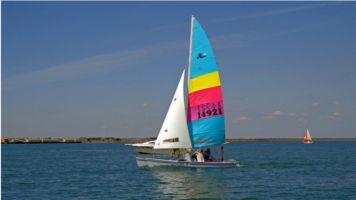TAMUmpower wrote:
I'm sorta new to all the details on how different designs work with different boats but the meat of it is that the faster a boat is naturally the less power it will need out of the sail and the more apparent wind it will create sailing downwind. So it can get by with a flatter sail and maintain the higher speed and jibe downwind and overall be faster to the mark. The opposite is true in the case of many monohulls which must have big curved symmetrical and asymmetrical sails and more or less sail very deep down wind.
The idea is that a wing/sail/foil with more camber or more shape generates more lift (hence more "power") at a given speed, at the expense of more drag. A thinner/flatter wing/sail/foil with less camber/shape generates less lift at the same speed, but also less drag. This is, in layman's terms, the concept behind "flaps" on an airplane. At takeoff and landing, the plane is travelling slower and needs to provide more lift at slower speeds, so it uses flaps to change the effective shape & camber of the wing, generating more lift, but at the expense of more drag. In order to go faster at altitude, the flaps are retracted. If you compare the cross-section of the wing on a fighter jet to the wing on a boeing, to the wing on a prop driven plane, you'll notice the same differences.
Because catamarans have less resistance in the water, they need to/can afford to generate less lift at any given apparent wind speed than a monohull, and therefore benefit from a reduction in drag. A fuller sail would generate a lot of lift, a lot of drag, and result in a slow boat that heels over constantly. In terms of spinnakers, you're looking at the same principles. A monohull uses a very full spinnaker as basically just a big parachute to pull the boat downwind - all drag, no lift. Catamarans use a reacher/spinnaker/code 0 to generate lift and drag both, using the apparent wind to maintain airflow over both sides of the sail. As far as which has more benefit on what angles - fuller or flatter, beam reach or broad reach, you'd have to talk to someone with experience experimenting with different sail shapes, probably a sailmaker. With all the science behind it, sailmaking is still somewhat of an artform.






